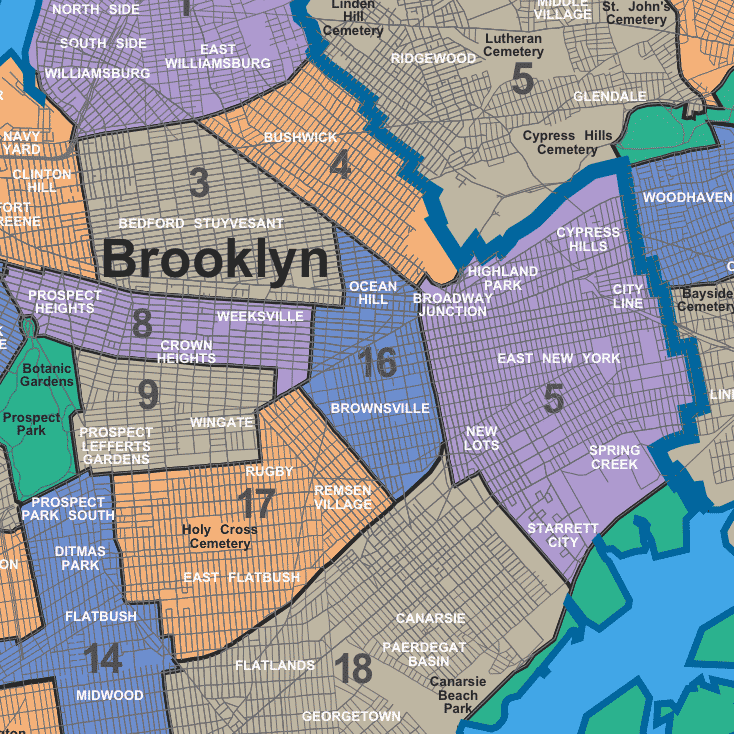City Politics
Highlights of Brooklyn CB8’s April 2014 General Meeting

On April 12, 2018 Brooklyn Community Board 8 (BK CB8) came together at Weeksville Garden Community Center to do the important work of improving the quality of life for the residents, nonprofits and businesses within its borders. Diederville, from NYS Assemblywoman Diana Richardson’s office, notified BK CB8 that Richardson will host an EFV Overdose Prevention and Intervention seminar on April 24, 2018, 10:00 am at East Flatbush Village, 309 Clarkson Avenue in Brooklyn. During the seminar, attendees will be trained in administering “Naloxone,” which is a nasal spray that reverses the effects of an opioid overdose.
Free intervention kits containing Naloxone will be distributed to the seminar attendees. Assemblywoman Richardson is on record for her concern over the drug epidemic in New York City and New York State as a whole. Richardson has brought to fore that drug abuse had been dealt with as a criminal justice issue for many years.
The assemblywoman is on record for asserting during the rampage of crack cocaine, “People were arrested and jailed; families were ripped apart and people received criminal records.” In more recent years, however, the opioid crisis is handled as a health issue. Richardson has requested restorative justice be instituted for those who went through the criminal justice system due to substance abuse.
On any given commercial corridor in New York City, people can spot white placards embossed with New York State’s insignia placed at the front windows of bars, lounges and eateries. These placards display the letter A, B or C to denote the enterprise’s sanitation grade. Keri Crayne, Special Projects and Communications Director of NYC DOHMH’s Bureau of Food Safety and Community Sanitation (Bureau of Food Safety), came before BK CB8 to explain how the bureau goes about inspecting all food services throughout the five boroughs to ensure food safety requirements are enforced.
The essential mandates include keeping food at the right temperatures, hand washing is consistently practiced, food is stored properly, inspecting for the presence of vermin, waste lines are covered, and that toilet facilities are maintained to a high standard. Ms. Crayne asked that New York City’s food industry work in alliance with the Bureau of Food Safety rather than avoid it. One way to establish this partnership is for restaurants and bars to elect for the bureau to perform consultative inspections. Crayne explained consultative inspections give restaurant owners the opportunity “to receive an inspection, ungraded and penalty-free to receive tailored advice about maintaining the best food safety practices at their establishments.” This type of inspection helps restaurants prepare for future inspections. The owners get information to improve their chances to earn an “A” rating.
Further, Crayne revealed that “there are uneven skill levels” within the body of inspectors which may keep the public guessing about just how clean is the kitchen, storage room, eating utensils are at a given establishment. New York City’s bars and eateries are critical to the tourism industry.
There are also supervisory inspections. These inspections operate wherein an inspector performs his/her duties and are followed up later by a bureau supervisor. Crayne pointed out that supervisory inspections have such snags as the time between the field inspector’s review and the supervisor’s review may record varying conditions at the time of the respective visits.
St. Senator Velmanette Montgomery attended this BK CB8 meeting to make a periodic report to the community. Montgomery commended BK CB8’s efforts in marketing the NYS Historic Residential Homeownership Rehabilitation Tax Credit (RHRTC).
This tax credit is available to “homeowners and is allowed a federal credit for the qualified expenses relating to the rehabilitation of a certified historic structure located in New York State, and all or part of the rehabilitation project is located within a census tract that is identified as being at or below 100% of the state median family income.” Over 130 RHRTC applications were approved for homeowners within the North Crown Heights Historic District. The state senator notified the body of the upcoming 2020 Census. Montgomery stated the need for more households to respond to the mailed survey instrument or the canvasser. Dreams YouthBuild is an educational and vocational program in service to young adults designed to lead them to self-sufficiency and higher education. Montgomery informed the body that the Dreams YouthBuild budget for New York State increased from $300,000 to $600,000. Further, an important win was made for health care services to low-income youth and immigrant youth. School principals may elect to construct School-Based Health Centers (SBHCs). The principal must secure construction or renovation funding. There exists currently 28 such centers throughout the five boroughs. At least six operate from Brooklyn schools. Interested school leaders ought to confer with NYC Education Department’s Office of School Health. BK CB8’s Livable Streets Committee—formerly the Transportation and the Sanitation & Environment Committees—reported on the state of Flatbush Avenue since the institution of the Mayor’s Clear Curb Initiative. Chairman Robert Witherwax stated this initiative entailed no parking or standing on Flatbush Avenue from Grand Army Plaza to Tillary Street for private and commercial vehicles during the 7 AM – 10 AM and the 4 PM -7 PM periods. The committee believes Clear Curb Initiative is deleterious for the businesses that operate on Flatbush Avenue because the two time periods are when most businesses get deliveries in the morning and when residents are shopping and businesses receive deliveries in the evening. The rationale for “Clear Curb” is to reduce road congestion by parking automobiles elsewhere. The fact is the initiative moves parked cars from Flatbush Avenue—a major four-lane thoroughfare—onto residential roadways that are primarily one lane that provide sufficient passing space for passenger cars, delivery trucks and emergency vehicles. This is counterintuitive to road hierarchy. The committee intends to make a motion to rescind the Clear Curb Initiative and request the NYC Department of Transportation to work with the North Flatbush BID and BK CB8 to develop an alternative plan.


